It has been said that just as a leopard can’t change his spots; so too, a tiger can’t change his stripes. Yet when it comes to military camouflage, the versatile tiger stripe camo pattern has changed and evolved over the years. The fact remains, however, that unlike the U.S. military’s Operational Camouflage Pattern (OCP) or Universal Camouflage Pattern (UCP), the iconic tiger stripe camouflage pattern was never actually an “official” form of camouflage.
Tiger Stripe Camo
While it has been called “tiger stripe camo” unofficially, as the name derives from its resemblance to the stripes on the big cats, it is unique in that the pattern has no name. And unlike OCP, UCP, or the other official camouflage patterns, tigerstripe camouflage is also not really one specific pattern. Some experts have suggested that there were nearly two dozen different variants, so it really is the name of a group of camouflage patterns rather than one particular pattern.
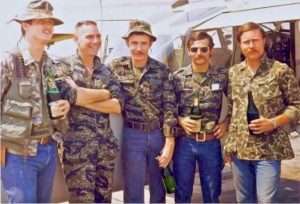
U.S. Navy SEALs wore locally produced tiger stripe uniforms in Vietnam – and yes, blue jeans were also commonly worn by the frogmen. (Photo: U.S. Navy/Public Domain)
“Tigerstripes are a blend of WWII British Windproof camo and French lizard patterns, and the first set was made in the late ’50s for the Vietnamese Marine Corps,” explained Bob Chatt, owner of high-end military collectibles shop Vintage Productions. Chatt has more than 30 years of experience dealing with Vietnam War-era collectibles and has seen more tiger stripe clothing than probably anyone else alive!
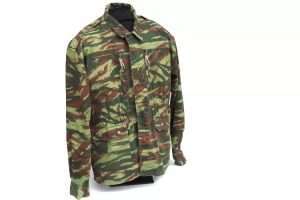
A late pattern French lizard camo jacket in the author’s collection.
“The very first tiger pattern was a locally-made copy of the French lizard pattern produced for the Vietnamese Marine Corps (Sọc Răn Thữy Quân Lục-Chiến). The pattern incorporates bold black stripes over lesser brownish-drab stripes & light green trace elements, with an olive green base color. Production of this design ended in 1967, although units continued to wear the pattern until 1970. Illustrated below are the original pattern (far left), followed by two variants designated sparse and dense.” Camopedia

TDI’s Tiger Stripe Collection: enter BANGING10 at checkout and save yourself 10%.
French Lizard Camo
As noted by Chatt, tiger stripe derived from the French lizard pattern, which was adopted by the French military after the Second World War. The French pattern itself– also known as TAP47 or Leopard pattern – evolved from the camouflage on the British paratrooper’s Denison smock. The French pattern featured overlapping prints that were generally green and brown over a lighter green or khaki. Items with this pattern were meant for use in the jungle terrain of Africa and Indochina.
It featured narrower stripes than the British camouflage, which was widely developed for use in the wooded terrain of Europe. The French lizard camouflage proved more than adequate at disrupting the vertical form of a soldier’s body. It was widely employed in French Indochina during the First Indochina War with the Việt Minh that led to the provisional division of Vietnam.
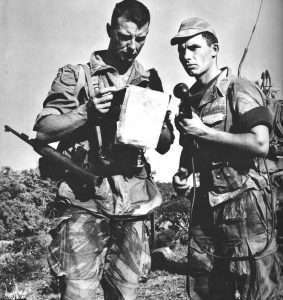
French soldiers in Indochina in the early 1950s wearing the lizard pattern uniforms, which proved quite adequate in the jungle terrain. (Photo: Public Domain)
The French Army continued the use of horizontal lizard patterns until after the Algerian War as it was felt it was too closely associated with the Paratroops Munity that called for French President Charles de Gaulle not to abandon French Algeria. However, a variant of the lizard pattern remained in use with the entire French Foreign Legion in the 1960s and by the French Foreign Legion paratroopers until the early 1980s.
The Israel Defence Force also used French lizard uniforms, which were supplied from French stocks – while several African countries including Chad, Gabon, Rwanda, and Sudan all adopted similar uniforms. The final country to use the pattern across its military was Congo, which only phased it out in 1978.
Portugal had also developed its own version of lizard camouflage that was similar to the French, but it featured vertical lines rather than horizontal lines. It was used from 1956 by elite paratroopers, then other units, and was worn in the Portuguese “Overseas Wars” in its African colonies. The pattern then became popular among the insurgent forces and was adopted by the armed forces in some of the former Portuguese African colonies, including Angola.
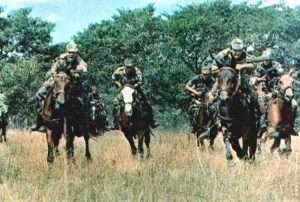
The Portuguese military wore its own version of lizard camo in its wars in Africa. The soldiers seem somewhat anachronistic, wearing modern camouflage while mounted on horses for a cavalry-style reconnaissance mission.
The vertical lizard pattern was adopted by Brazil, which had retained close ties to Portugal, but also by such nations as Egypt, Greece, India, and Syria – but the colors have tended to be less tropical and more desert oriented with those respective patterns.
A Communist Bloc version was adopted by Soviet Special Forces while Cuban forces also adopted a pattern that evolved from the variant used by Angolan forces – of which Cuba had sent advisors.
During the early stages of the Second Indochina War – what we know more commonly as the Vietnam War – the pattern was modified by the South Vietnamese Armed Forces (ARVN). It featured brushstrokes that interlocked more than overlapped and featured less background color than the French lizard pattern/TAP47 version.

Tiger stripe camo goodness from Tactical Distributors.
Vietnam Tiger Stripe Camo: Officially Unofficial
Sometime from late 1962 to early 1963 it was adopted by U.S. advisors and Special Forces in Vietnam. As noted previously it was never an official U.S. issue item, but special operators preferred the locally made uniforms as these proved more durable and blended in better to the terrain than the olive drab uniforms used by the U.S. Army at the time.
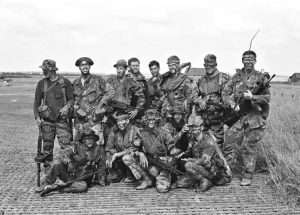
Throughout America’s involvement, a variety of camouflage – much of it locally made – was used in Vietnam. These Navy SEALs are wearing tigerstripe camouflage among other patterns. (Photo: U.S. SEAL Museum/Public Domain)
Marine Corps advisors also had contracted Vietnamese tailors as well as Southeast Asian manufacturers to produce fatigues as well as Boonie hats. The tigerstripe uniforms were manufactured across the region so there is a wide variety of patterns and color shade variations.
“During Vietnam, tigerstripes were made in Vietnam, Thailand, Japan, Okinawa, Taiwan, Philippines, and Korea,” said Chatt. “No one will ever know how many different patterns there were as every tailor shop could and did print their own patterns.”
The other fact about tiger stripe camouflage is that it was universally appreciated by those who were “in-country” during the Vietnam War.
“Not only Special Forces type units wore them, infantry, Air Force para-rescue & Air Police, Marines, Riverine – anyone who had access to them would wear them,” added Chatt.
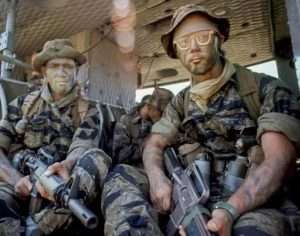
Soldiers, possibly of the 173rd Airborne, in tiger stripe pattern cammies.
ERDL
However, because it was never official and moreover because it wasn’t “uniform,” as the war progressed, other camouflage patterns were introduced. These included the-then-new ERDL camo pattern, which was (after camouflage evaluation trials) the predecessor of the woodland BDU pattern. This was used by SOF soldiers and specialty units, and is sometimes mistaken or even misidentified as tiger stripe camo. However, these are two distinct patterns.
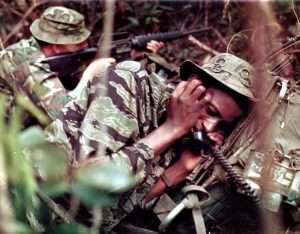
A Tiger stripe camo uniform (foreground) and ERDL pattern (background) in use by US forces in Vietnam circa 1969. (Photo: Public Domain)
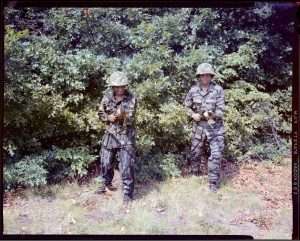
Tiger Stripe camo and ERDL camo pattern during camo trials, 1975, via Soldier Systems Daily.
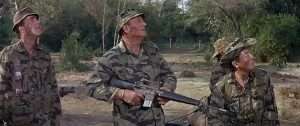
John Wayne, in the 1968 film The Green Berets, the only Vietnam War film to have the support of the U.S. military. Wayne and the Jim Hutton can be seen wearing one variation of tiger stripe while the actors playing the ARVN soldiers are wearing another type. Such differences were actually common in Vietnam. (Photo: IMFDB/Public Domain)
Allied Tiger Stripes
During the war, the pattern was also used by Australian and New Zealand forces including the Australian Special Air Service Regiment and the New Zealand Special Air Service. As the war wound down, so too did the use of the tigers tripe camouflage by the U.S. military and its allies.
After the war tiger stripe camo didn’t exactly go away, but unlike the tigers that can’t change their stripes, the shops did adapt to the changing market. Tigerstripe continued to be produced and was marketed in many of the same shops but to tourists. In addition, while the United States ceased using tigerstripe after the Vietnam War it remained in use in the Philippines and other places.
(Meanwhile, in Marawi…)
In recent years the Australian military has introduced it for use in OPRFOR (opposition force) roles.
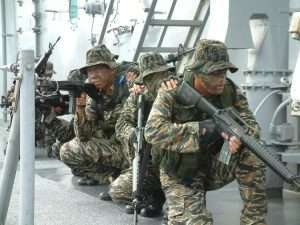
Members of the Philippine Army wear a 21st-century version of the tiger stripe that isn’t really that much different from what was worn in Vietnam 50 years ago.
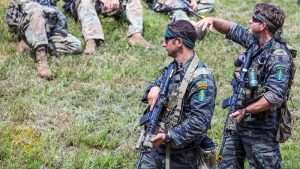
U.S. Special Operations soldiers (specifically, in this case, some Green Berets with the 5th Special Forces Group) also use tiger stripe camo in OPFOR (OPposing FORces) roles.
For collectors, it remains difficult to know if a particular item was, in fact, used during the war. Reproduction and modern fakes have further muddied the waters for collectors. As with most items of a military nature, it is best to buy the piece, not the story that comes with it.

A reproduction tiger stripe jacket that, apart from the age, is almost identical to those made in the country decades ago. If anything, the quality of the reproductions is often superior to the originals! (Photo: Private Collection)
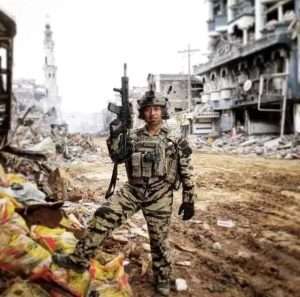
Philippine SOF soldier in modern tiger stripe camo during the Battle of Marawi.
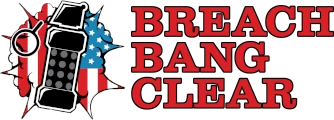
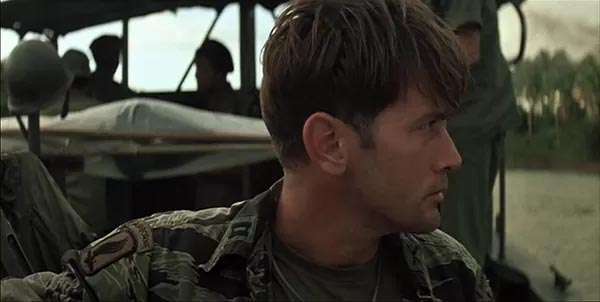


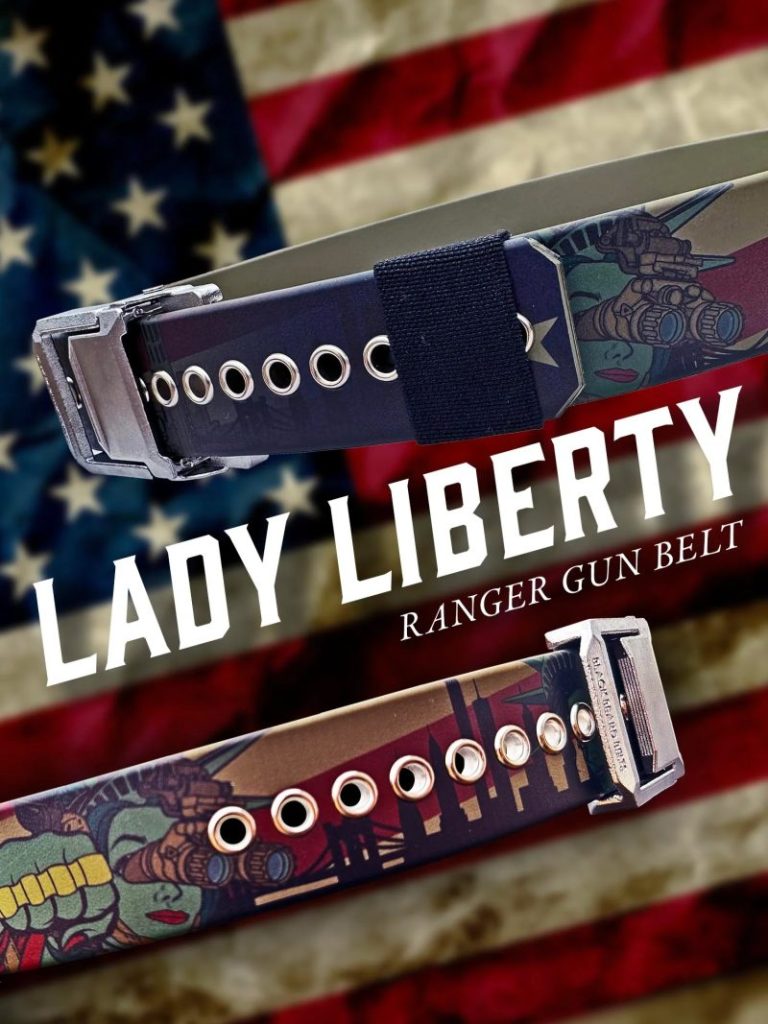
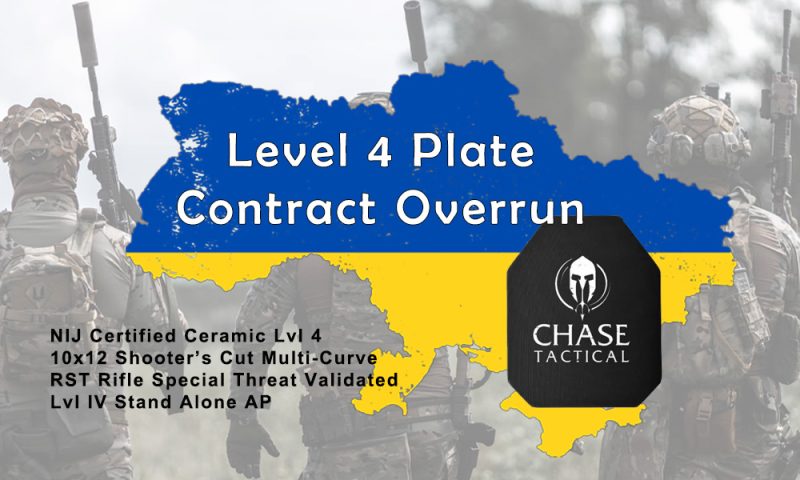



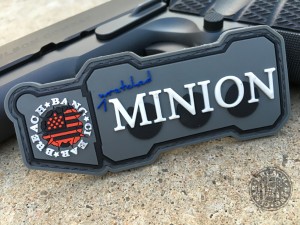
0 Comments